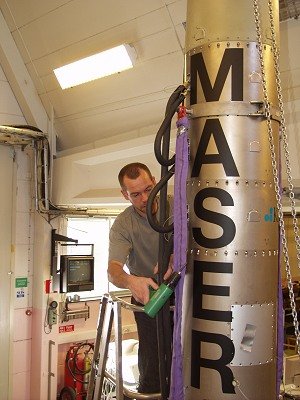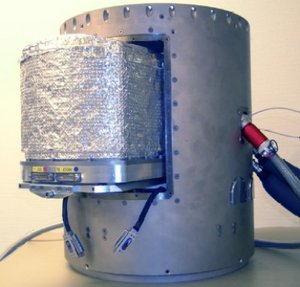More about Maser 10 payload
The Maser 10 payload contained four experiment modules with two biology and three fluid physics experiments:
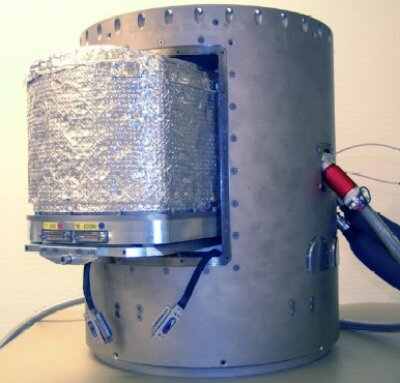
1. Biology in Microgravity (BIM):
This experiment module is a new development for two biological experiments: ACTIN and AMUSE.
The ACTIN experiment investigates the role of microgravity on actin metabolism in mammalian cells. It is performed by Prof. J. Boonstra from the University of Utrecht (the Netherlands). Experiments in space reveal that gravity affects many processes in the human body, for example bone growth, heart function and immunity capability. The aim of the ACTIN experiment is to identify the gravity sensitive component that underlies the actin filament metabolism. A wide variety of proteins, amongst them proteins of the Rho and Rac family, profilin, gelsolin and many others have been demonstrated to play a regulatory role in actin polymerisation or actin depolymerisation. It is the aim of this research to establish the expression, activity and localisation of these proteins in microgravity conditions.
AMUSE investigates the influence on activation of NF-kappaB. The experiment is performed by Prof. M. Peppelenbosch from the University of Groningen (the Netherlands). NF-kappaB is a protein that acts as a principal regulator of inflammation and immunity in the human body. This is why the protein plays a crucial role in the occurrence of autoimmune diseases, like asthma, rheumatoid arthritis and allergies. The experiment shall give indications which will enable the development of new treatments for patients suffering from autoimmune diseases. Its primary objective is to establish whether microgravity results in inhibition of NF-kappaB-dependent signal transduction. As a secondary objective, the experiment will try to establish the actual molecular target of microgravity in the putative inhibition of NF-kappaB-dependent signalling.
2) Interfacial Turbulence in Evaporating Liquids (ITEL-2):
This fluid physics experiment is a follow-up to that flown on the MASER 9 mission in 2002. The experiment is performed by Dr. P. Colinet from the Free University of Brussels (Belgium).
The objective of the experiment is to analyse the fluid dynamics of an evaporating liquid. A highly volatile liquid (ethanol) is evaporated and the convection phenomenon generated in the evaporation process is observed. The interaction between the evaporation process at the surface of a liquid and the subsequent Marangoni forces and liquid movements is a complicated process with the creation of intermediate instabilities.
This interaction is in particular strongly disturbed by gravity, which makes it difficult to observe on Earth. Therefore, an experiment under microgravity conditions gives results that can be interpreted much more easily. During the flight, the experiment was observed with a suite of sophisticated optical instruments and images were recorded by three digital video cameras.
3. Thermal Radiation Forces in Unsteady Conditions Experiment (TRUE-2):
The objective of the TRUE fluid physics experiment, performed by Prof. F.S Gaeta from MARS Center in Naples (Italy), is to measure the effect of Thermal Radiation Forces on a solid disc embedded in a liquid and crossed by a heat flux during a thermal transient. According to the theory of Thermal Radiation Forces the heat flux results in a force on the disc, which is measured by a specially developed highly sensitive force sensor. The interest of the experiment is to reduce the present uncertainty on the value of forces to be expected and to validate the theoretical model. The measurements have to be done under microgravity to eliminate the buoyancy forces and convection, which arise from density gradients under 1g on Earth.
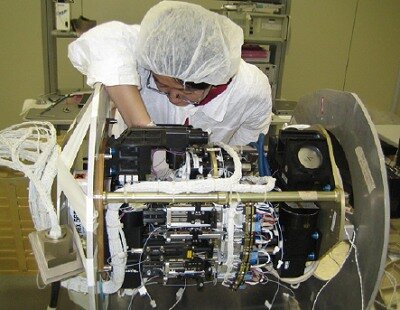
4. Chemically-Driven Interfacial Convection (CDIC):
In many industrial chemical processes two immiscible liquids react at the interface between them. In cases where the reaction product is lowering the interface energy, interesting and complicated interface structures appear and couple back to the process. To understand this complicated and interesting interaction, the elimination of the disturbing influence of gravity is necessary. The CDIC fluid physics experiment required the development of a new experiment module under ESA contract.
The experiment is performed by Dr Eckert from the Technical University of Dresden (Germany), in cooperation with Dr A. De Wit and Dr. P. Boon from the Free University Brussels (Belgium). The main goal of this experiment is a basic understanding of chemically driven interfacial convection, i.e. the convection between two interfacing liquids. It looks in particular into the following aspects: the mass transfer to the interface, the chemical reaction between the two liquids, the generation of concentration gradients, the amplification or damping of concentration perturbation, the generation of interfacial tension gradients and the redistribution of the gradients in concentration, leading again to changes in mass transfer. Special attention is paid to the effect of concentration gradients that can lead to strong deformations of the interface that are called 'fingering' patterns.
Telemetry data
The Service Module, which is part of the payload, handles the communication between the experiment facilities onboard and the scientists in the ground station during the MASER flight. It has been developed by the Swedish Space Corporation (SSC) and the German Space Center DLR on behalf of ESA and has flown two times before, on MASER 8 in 1999 and MASER 9 in 2002. It provides the operators and scientists on the ground with telemetry data from the experiment modules and enables them to send telecommands to control the experiments.
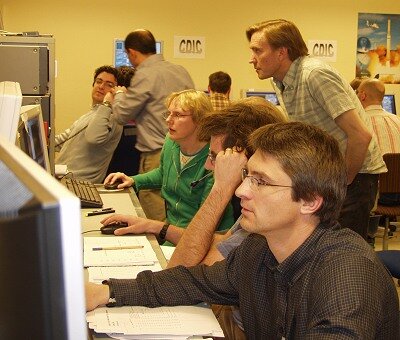
On MASER 10 a digital video system provided compressed realtime video images from seven cameras installed in two of the experiment modules. Thanks to this capability to receive data and send back commands to the experiments in realtime during the flight, the performance and thus the scientific output of the three fluid physics experiments could be optimized by the investigators during the MASER 10 mission. During the ascension flight and the microgravity period of the mission the Service Module has transmitted experiment data to the ground. However, upon reentry it suddenly stopped working. The payload engineer succeeded in restarting the operations for about 30 seconds, but then the transmission of data was discontinued for the rest of the mission.
The data and uncompressed video images stored onboard in memory cards and on video tapes are still readable, despite the shock at impact. However, the experiment facilities themselves, developed by ESA for the scientists participating in sounding rocket missions, have been damaged to an extent that they cannot be repaired and reused for future missions.
The situation for the two biological experiments is different since both experiments do not solely rely on telemetry data, but require the physical recovery of biological experiment samples for the scientific evaluation. Despite the crash landing, 14 out of the 16 ACTIN experiment units were recovered in a state that they can still be analysed scientifically. For the AMUSE experiment the ratio is six out of eight. Unfortunately, two of its microgravity units were destroyed.


